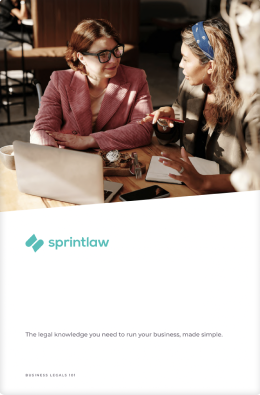Contents
Shareholders agreements are a hugely important document for any company. This contract between the shareholders dictates the conduct, rights and duties every shareholder is bound by.
As a result of this, shareholder agreements often contain clauses that allow shareholders certain rights in order to protect their interests.
However, not all provisions protect all shareholders alike. Drag along and tag along clauses are largely popular in shareholders agreements – one protects the interests of majority shareholders, while the other looks out for minority shareholders.
Let’s explore them in more detail below.
What Is A Shareholders Agreement?
Firstly, it’s important to understand what a Shareholders Agreement is. The document is a legally binding contract between the owners of the company, also known as the shareholders.
The agreement dictates matters that are crucial to how the company is run, including:
- How decisions are made
- Who the shareholders are
- What portion of shares each shareholder possess
- Voting and meetings
- The relationship between shareholders and directors
- Dispute resolution
- Transferring shares
- Shareholder rights and responsibilities
What happens between shareholders will ultimately impact the entire company. Therefore, documents governing their conduct must be precise, detailed and align with the values of the company.
Getting a legal professional to help draft your Shareholders Agreement can make sure you have a contract that works in your company’s best interests. For example, a lawyer can insert clauses that will protect your business in your specific field.
When Would I Need A Shareholders Agreement?
If the company has more than one shareholder, it’s important to get a shareholders agreement as early on as possible. Shareholders agreements can be adjusted or drafted at a later date, however, it’s best to have all the terms laid out before any party engages in a commitment.
A shareholders agreement is also beneficial if your company plans on to grow bigger or expand more in the future. As business activities become more complex, so too will your documents and regulations.
What Is A Drag Along Clause?
A drag along clause is a provision that can be found in a shareholders agreement. Drag along clauses are essentially a right that majority shareholders possess.
During a business sale, drag along rights allow majority shareholders to force minority shareholders to sell their shares as well (under the same or similar terms). This way, the sale or transaction of the company cannot be impacted by the refusal or a minority shareholder.
What Is A Tag Along Clause?
Tag along clauses are provisions that have been designed to safeguard the interests of minority shareholders.
Tag along provisions can be enacted when a majority shareholder is selling their shares to a third party buyer. In this case, the minority shareholder can use the provision to ensure a sale is also made for their shares from the same buyer, under the same terms and price.
Therefore, if a majority shareholder is exiting the company, the minority shareholder has the option to leave with them as well.
When Would I Use Drag Along And Tag Along Clauses?
Let’s take a look at how drag along and tag along clauses would play out in certain scenarios.
| Example Dave is considered a majority shareholder of a company. However, this company is being acquired by a much larger company. Dave feels he’s getting a great deal for his shares and it’s time to exit the company, however, a few of the minority shareholders are not convinced this is the right move. Rather than letting the sale fall through, Dave is able to make the minority shareholders sell their shares (with the same terms and price as his) in order to complete the transaction. In this scenario, Dave used the drag along clause to force the minority shareholders into selling their shares. |
| Example Beverly is a minority shareholder in a startup. The business has been doing well, however, one of the majority shareholders is leaving the company and selling their shares to a third party buyer. Beverly is hesitant to stay on board with a different majority shareholder taking over. Therefore, Beverly enacts the tag along clause from their shareholders agreement in order to secure herself a sale for the same terms from the third party buyer, allowing her to exit the company as well. The tag along clause gave Beverly options when a scenario out of her control occurred. |
How To Transfer Shares To Another Person
A shareholders agreement is also likely to contain provisions regarding what happens when someone wants to exit their company by selling their shares. Often, other shareholders will have pre-emptive rights. This means the shareholder looking to exit the company must offer their shares to the existing shareholders first before finding a third party buyer.
If no existing shareholders are willing to buy the shares, then a transaction is made between the former and new shareholder. Once they are the new shareholder, they will likely need to sign internal documents such as the shareholders agreement.
After their position as a shareholder in the company has been formalised, the company must notify the Australian Securities and Investments Commission (ASIC) within 28 days.
Key Takeaways
Drag along and tag along clauses can help protect the interests of both minority and majority shareholders. It’s always good to seek the help of a legal professional when drafting these clauses as part of your shareholders agreement.
To summarise what we’ve discussed:
- A shareholders agreement is the contract between the shareholders of the company, and it governs their conduct
- It’s important to get a shareholders agreement as soon as the company has more than one shareholder
- A drag along clause can force minority shareholders to sell their shares when the company is being sold
- A tag along clause gives minority shareholders the right to seek a sale for themselves under the same terms with the same buyer when a majority shareholder is selling their portion of shares
- The process to transfer shares can often be found in the shareholders agreement, after which the transaction is complete and ASIC needs to be notified
If you would like a consultation on drag and tag along clauses, you can reach us at 1800 730 617 or team@sprintlaw.com.au for a free, no-obligations chat.
We'll get back to you within 1 business day.











